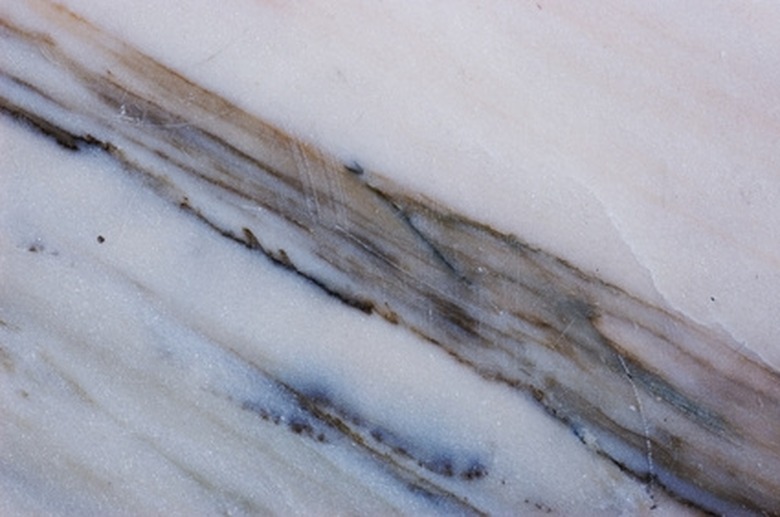Marble Vs. Quartzite
Marble and quartzite are rocks that are at once both similar and dissimilar. Though they share certain functions and physical features, marble and quartzite differ from each other in chemistry, formation, durability, source locations and commercial viability.
Chemistry
Chemistry
Marble is a mineral that is made up of calcite (calcium carbonate, CaCo3). Chemical impurities add to this formula, as do physical inclusions. Quartzite, unlike marble, is not a mineral. It is made up of quartz sandstone, a sedimentary rock. Due to being mostly quartz its basic chemical formula is SiO2 (silicon dioxide, the same as quartz). It too can include impurities, both physical and chemical.
Formation
Formation
Both quartzite and marble are metamorphic rocks, meaning that although they undergo change via pressure and heat they don't melt. Marble comes from dolostone (limestone with dolomite) or limestone. Quartzite comes from quartz sandstone when the quartz grains of the sandstone are fused due to pressure and heat. Both quartzite and marble tend to form via regional metamorphism (more pressure than heat) and contact metamorphism (more heat than pressure). Also a shared feature is their tendency to form more often from regional metamorphism.
Marble Features
Marble Features
Marble is a non-foliated (cannot be broken into layers) metamorphic rock that is white when pure and is stronger than the rock from which it forms (parent rock). It possesses weak chemical bonds (is susceptible to attack from acids), and easy to carve and polish. Marble may also become foliated when it forms in limestone that is alternately layered with shale. Due to chemical impurities in the parent rock, marble can take on color such as:
- mica
- chlorite
- wollastonite
- garnet
The veracity of a stone that may be marble can be verified by placing an acid on it to see if the stone chemically reacts. If the stone really is marble it will fizz on contact with the acid.
Quartzite Features
Quartzite Features
Like marble, quartzite is non-foliated, metamorphic, white when pure, and is stronger than its parent rock. Also like marble it can form in a range of colors (including purple, green blue, brown, yellow and black) depending on the parent rock's mineral impurities, but commonly it appears as a dark gray or light pink. Unlike marble, quartzite is a tough mineral, being very resistant to both mechanical weathering (physical abrasion) and chemical weathering. Also distinguishing for quartzite is that it breaks across its quartz grains, due to being made of fused quartz, unlike regular sandstone, which breaks into grains.
Function
Function
Quartzite is used as a construction material for such items as roof tiles, steps, walling material and flooring material, and is also used for railway ballast. More pure quartzite can be used to make ferrosilicon, silicon carbide and silica sand. Marble is also used in buildings, for such things as floor tiles, counter tops, tabletops and lavatories. However, marble is also used for monuments and sculpture, where white marble is most popular.
Location
Location
Marble is found around the planet, notably in Italy, Turkey, Poland, Spain, China, Ireland, Greece, Mexico, Afghanistan, Tyrol, Austria, Argentina, Canada, Norway and the United States. Within the United States marble sources of note include Vermont, Colorado, Tennessee, Georgia and Alabama.
Quartzite is also found in a large range of places, including: the United Kingdom, Australia, Sweden, the Czech Republic, Norway, Italy, Pakistan, South Africa, Canada and the United States. In the United States it is notably found the Eastern states such as Pennsylvania and New York, but is also found in Montana, Pennsylvania, Idaho, South Dakota, Minnesota, Arizona and Wisconsin.
Cite This Article
MLA
Reinbold, Joan. "Marble Vs. Quartzite" sciencing.com, https://www.sciencing.com/marble-vs-quartzite-6667913/. 24 April 2017.
APA
Reinbold, Joan. (2017, April 24). Marble Vs. Quartzite. sciencing.com. Retrieved from https://www.sciencing.com/marble-vs-quartzite-6667913/
Chicago
Reinbold, Joan. Marble Vs. Quartzite last modified August 30, 2022. https://www.sciencing.com/marble-vs-quartzite-6667913/
